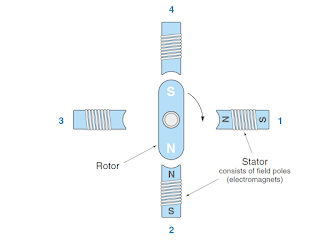Stepper and Servo motors find key applications in motion control.
So what are stepper motors?
Stepper motors are discrete motion devices that move to positions that relate directly to the number of input control pulses, at a velocity that relates directly to the pulse rate.
DC brush servomotor
Generally a
motion control system consists of:
- The mechanical part being moved
- The motor (stepper or servo) with a feedback to provide an indication of actual position
- Intelligent controller
- The motion driver unit
- Programming and operator interface software
Driving a
controlled current through a number of coils within the motor generates the
magnetic forces in a motor. Depending on their design, motors have many coils
oriented in specific magnetic positions within their housing. By pulsing or
steady control of current through different motor coils in a known pattern,
electromagnetic fields develop in the motor, causing incremental or continuous motion.
The current
and voltage that drives a motor typically comes from a power electronics
device, known as an amplifier or power drive. Stepper and servo motors are
located between the motion controller elements.
So what are stepper motors?
Stepper motors are discrete motion devices that move to positions that relate directly to the number of input control pulses, at a velocity that relates directly to the pulse rate.
Stepper
motors rely on the principle of commutation or alternating magnetic forces to
provide predictable controlled motion.
Commutation in motion applications is the
controlled sequencing of drive currents and voltages in motor coil winding to
provide torque and therefore, movement.
In a stepper
motor system, individual signals from a motion controller are converted into an
energizing pattern for the motor.
As the
commutation pattern varies, the motor moves from one discrete position to
another.
When the
pattern is held in a single state, the stepper motor holds its position with a
known torque also called holding torque. These single-state locations are known
as the full-step locations of a stepper motor. One key stepper motor
specification is the number of full steps per revolution (rotary motion) or
full steps per unit length (linear motion).
The
steps/revolution parameter of a stepper motor indicates the basic resolution of
the motor.
Let’s
consider a stepper motor with a resolution of 200 steps/revolution, which can
also be referred to as a 1.8 degree/step motor. If the motion controller
outputs 200 steps to a full-step motor driver connected to a 1.8 degree stepper
motor, the resulting movement would be a full 360° of the movement or one
revolution of the motor. If those 200 steps were generated evenly over a period
of one minute, the speed of rotation of the motor would be one revolution per
minute (RPM).
Having
looked at the stepper motors, let us now learn more about Servo motors.
Servomotors are continuous motion devices that
use feedback signals to provide position and velocity control in a closed loop
system.
The primary
types of Servomotors are DC brush servo and brushless servo.
An open loop
servomotor rotates or moves uncontrolled as long as the power is applied to it.
By
implementing a control loop around a servomotor using a PID controller and
feedback from an encoder device mounted on the motor, it is possible to
accurately and reliably move to the desired position at well controlled velocities
following your specified motion trajectory paths.
All
servomotor systems use a motor driver pattern power unit to control the voltage
and current that flows through the motor armature and motor winding.
The basic
principle of motion in servo motors is based on the flow of current through wire
coil, generating a magnetic field that reacts with permanent magnets in the
motor to cause attraction and repelling forces that cause movement.
You can also read: Closed Loop Control System
You can also read: Closed Loop Control System
DC brush servomotor
This is the
simplest servomotor design. Actually it is cost effective for its performance
and power in general servo applications.
DC brush
servo motors are self-commutating motion devices that rotate continuously while
current is applied to the motor brush contacts. The current flows through the
brushes to the armature and then through the motor coils, creating the magnetic
forces that cause motion. Changing the direction of the current flow through
the motor reverses the direction of rotation.
Encoder
feedback to the motion board is required to provide accurate control of
position and velocity with a DC brush servomotor. Encoders are mounted on the
shaft of a motor or on the coupled mechanical unit as a linear or rotary
device, directly translating movement into feedback data.
Don't miss out on key updates, join our newsletter list here.

No comments:
Post a Comment